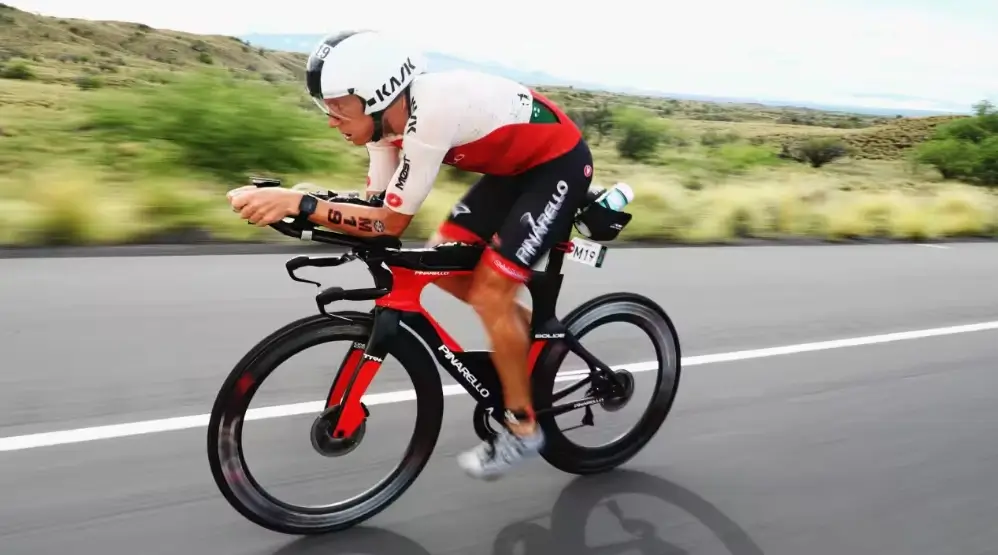
When you think of athletes who dominate multiple sports at the highest level, few names command as much respect as Cameron Wurf. The 41-year-old Australian is a rare breed – a professional cyclist racing for the elite Ineos Grenadiers team while simultaneously crushing Ironman competitions worldwide. His reputation for delivering legendary bike splits that redefine what’s possible in triathlon has made him one of the most feared cyclists on any course.
The Engine Room: Cameron Wurf’s Record-Breaking Bike Splits
Cameron Wurf possesses what many consider the most powerful cycling engine in triathlon history. His ability to sustain monstrous watts for hours while maintaining perfect aerodynamic position has produced some of the most jaw-dropping bike splits the sport has ever witnessed.
The Australian’s cycling prowess stems from his unique dual-sport career. Racing alongside Tour de France winners and WorldTour professionals with Ineos Grenadiers provides him with a competitive edge that pure triathletes simply cannot match.
The Legendary Ironman Texas Bike Record
Cameron Wurf produced a sensational 3:53:32 bike split at Ironman Texas in 2025 – the fastest time recorded on two wheels in an Ironman race. This phenomenal performance shattered the previous world record by over a minute, establishing a new benchmark that may stand for years.
Covering the 180 kilometers of the bike segment at an average speed of 46.2 kilometers per hour, Wurf’s Texas performance was nothing short of extraordinary. The conditions were typical Texas heat and humidity, making his sub-3:54 split even more remarkable.
Other Notable Ironman Bike Records
Cameron Wurf’s record-breaking ability extends far beyond Texas. At the Hawaii Ironman, he recorded a 180km time trial in 4:12:54, over five minutes faster than the previous record. This performance at Kona demonstrated his consistency across different courses and conditions.
His Ironman Wales victory also featured a course record bike split, proving that his cycling dominance isn’t limited to specific venues or conditions.
Cameron Wurf’s Top Race Results
| Race | Year | Bike Split | Final Time |
|---|---|---|---|
| Ironman Texas | 2025 | 3:53:32 | 7:58:45 |
| Ironman Hawaii (Kona) | 2024 | 4:09:06 | 8:12:35 |
| Ironman Frankfurt | 2023 | 4:15:22 | 8:18:12 |
| Ironman Wales | 2022 | 4:18:45 | 8:09:33 |
The Man Behind the Medals: Cameron Wurf’s Bio & Stats
Cameron Wurf represents the pinnacle of endurance sports versatility. His unique position as both a WorldTour professional cyclist and elite triathlete makes him one of the most fascinating athletes in either sport.
Team Affiliation
Cameron Wurf is unique in that he is both a WorldTour pro and a professional triathlete. His role with Ineos Grenadiers allows him to race at cycling’s highest level while maintaining his triathlon career. This dual-sport arrangement is unprecedented in professional cycling.
Cameron Wurf is both a member of Team Ineos Grenadiers and an accomplished professional long course triathlete. The team supports his triathlon pursuits, understanding that his endurance base benefits his cycling performance.
Key Stats
Cameron Wurf stands 1.71m tall and weighs 71kg, giving him an ideal power-to-weight ratio for both cycling and triathlon. His compact frame allows for excellent aerodynamics while maintaining the strength needed for sustained power output.
Born on August 3, 1983, in Sandy Bay, Australia, Wurf’s journey to elite sport began in rowing before transitioning to cycling and eventually triathlon.
Background
Cameron Wurf’s athletic career began in rowing, where he developed the cardiovascular base that would later serve him in cycling and triathlon. After initial success in professional cycling, he temporarily retired in 2014 to focus on triathlon before returning to the WorldTour with Ineos Grenadiers.
His unique background allows him to approach training and racing from multiple perspectives, contributing to his exceptional versatility.
The Champion’s Garage: Cameron Wurf’s Gear
Cameron Wurf’s equipment choices reflect his dual-sport status and obsession with aerodynamic efficiency. His gear setup is carefully calibrated for maximum performance across both disciplines.
Bike
As an Ineos Grenadiers rider, Cameron Wurf races on Pinarello bicycles, utilizing the same cutting-edge technology as his Tour de France-winning teammates. His time trial setup features aggressive aerodynamic positioning optimized for sustained power output.
His Ironman bike setup includes deep-section wheels, aerodynamic handlebars, and a position refined through countless hours of wind tunnel testing and real-world racing.
Other Gear
Cameron Wurf relies on lightweight, aerodynamic helmets designed for maximum airflow and minimal drag. His wheel selection varies by course, but consistently features deep-section carbon rims for optimal aerodynamics.
His running shoe choices prioritize comfort and efficiency for the marathon portion of Ironman races. For more on what makes a shoe race-legal, check out our definitive guide.
Cameron Wurf’s fastest Ironman bike split is 3:53:32, set at Ironman Texas in 2025. This performance established a new world record for the fastest cycling segment in Ironman history.
Yes, Cameron Wurf remains an active member of Ineos Grenadiers. At 41 years old, he continues to balance his WorldTour cycling career with professional triathlon competition. His dual-sport arrangement is unique in professional cycling.
Cameron Wurf has won Ironman Wales and achieved multiple podium finishes across various Ironman events. His consistency at the highest level has established him as one of the sport’s most reliable performers.
Cameron Wurf has consistently performed well at Ironman Frankfurt, with his bike splits often setting the pace for the entire field. Ironman Frankfurt His 2023 performance included a 4:15:22 bike split that dominated the cycling portion of the race.
Cameron Wurf continues to redefine what’s possible when elite cycling meets Ironman triathlon. His unique career path and record-breaking performances make him one of the most compelling athletes in endurance sports today.


Pingback: The Texas Threepeat: Kat Matthews Rewrites History With Blistering 8:10 World Record - besttriathletes.com
Pingback: Lionel Sanders Sets New Bike Course Record at 2025 IRONMAN 70.3 St. George - besttriathletes.com
Pingback: IRONMAN 70.3 Chattanooga 2025: Sam Long and Grace Alexander Triumph in Swim-Less Challenge - besttriathletes.com
Pingback: IRONMAN Frankfurt 2025: Complete Analysis of Elite Men's Race Performance - besttriathletes.com